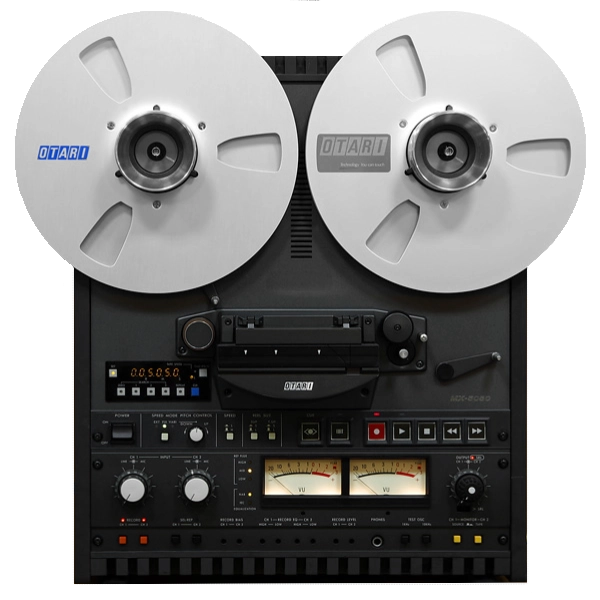The Otari MX-5050BIII tape recorder is a professional-grade device renowned for its versatile features and robust construction. Here’s an expanded breakdown of its key attributes:
- Record Setup Adjustments: The MX-5050BIII offers convenient front-panel access for adjusting record setup parameters, allowing users to fine-tune recording settings without the need for complex procedures.
- Built-in Oscillator: The inclusion of a built-in oscillator simplifies the calibration and maintenance process by providing readily accessible test tones, ensuring accurate alignment and performance over time.
- Servo-Controlled Direct Drive Capstan Motor: The capstan motor in the MX-5050BIII operates with precision thanks to servo control, ensuring consistent tape speed for high-quality recordings and playback.
- Integral Microprocessor: Tape handling operations are managed by an integral microprocessor, which oversees functions such as dynamic braking, motion sensing, and transport logic. This enhances operational efficiency and reliability.
- Mini-Autolocator: The MX-5050BIII features a built-in mini-autolocator, offering convenient one-touch cue-point memories, search zero capability, and a repeat function, streamlining the editing and playback process.
- Tape Timer Display: The tape timer display provides comprehensive information including tape time in hours, minutes, and seconds, as well as tape speed in inches per second and percentage of tape speed, allowing for precise monitoring during recording and playback sessions.
- Capstan Speed Control: Users have the flexibility to vary the capstan speed by up to ±20% in precise 0.01% steps using the built-in “pitch” control, enabling fine adjustments to match specific recording requirements.
- Timecode Editing via Synchronizer: Integration with a synchronizer via the 37-pin Otari standard parallel interface facilitates seamless timecode editing, enhancing workflow efficiency and accuracy in professional recording environments.
- Rugged Mechanical Construction: The MX-5050BIII is built to withstand demanding usage conditions, featuring a 1/4″ deckplate, cast aluminum side panels, and steel support members. This rugged construction ensures durability and long-term reliability.
- Service Accessibility: For ease of maintenance and serviceability, all circuit boards are designed to swing out or unplug easily, allowing for quick access when troubleshooting or performing routine maintenance tasks.
From a historical perspective, the Otari MX-5050BIII tape recorder represents a significant advancement in professional audio recording technology. Introduced during a time when analog tape recording was at the forefront of the industry, the MX-5050BIII quickly established itself as a flagship model renowned for its innovative features and rugged construction.
During the era in which the Otari MX-5050BIII emerged, analog tape recording was the primary method for capturing and reproducing audio. However, the technology was undergoing rapid evolution, with manufacturers striving to enhance both performance and user convenience. In this context, Otari’s introduction of the MX-5050BIII marked a milestone in the tape recorder’s evolution.
One notable feature of the Otari MX-5050BIII was its front-panel accessibility for record setup adjustments. This innovation simplified the recording process, allowing engineers and producers to fine-tune parameters with ease, thereby streamlining workflow and enhancing productivity in professional recording studios.
Furthermore, the inclusion of a built-in oscillator for calibration and maintenance underscored Otari’s commitment to ensuring consistent performance and reliability. This feature addressed a common challenge faced by audio professionals, providing them with readily accessible test tones for accurate alignment and calibration of the device.
The Otari MX-5050BIII’s servo-controlled direct drive capstan motor represented another significant advancement. By employing servo control, Otari achieved precise control over tape speed, resulting in high-quality recordings with minimal speed variations—a crucial consideration for achieving professional audio fidelity.
The integration of an integral microprocessor further enhanced the MX-5050BIII’s capabilities, governing essential tape handling functions such as dynamic braking and transport logic. This not only improved operational efficiency but also contributed to the device’s overall reliability and user experience.
Additionally, the Otari MX-5050BIII introduced features such as the mini-autolocator, tape timer display, and capstan speed control, further elevating its appeal among audio professionals. These features provided enhanced functionality and convenience, empowering users to achieve greater control and precision in their recordings.
From a construction standpoint, the MX-5050BIII was built to withstand the rigors of professional use. Its rugged mechanical design, featuring a 1/4″ deckplate, cast aluminum side panels, and steel support members, ensured durability and longevity—a crucial consideration for equipment operating in demanding studio environments.
Overall, the Otari MX-5050BIII tape recorder emerged as a hallmark of innovation and reliability during a pivotal period in audio recording history. Its advanced features, coupled with robust construction, solidified its position as a preferred choice among audio professionals worldwide, leaving an indelible mark on the evolution of recording technology.





